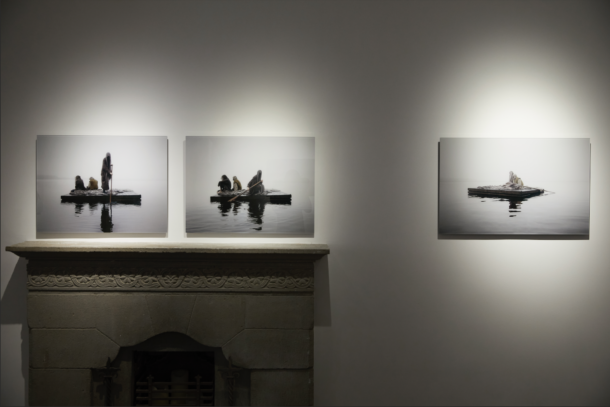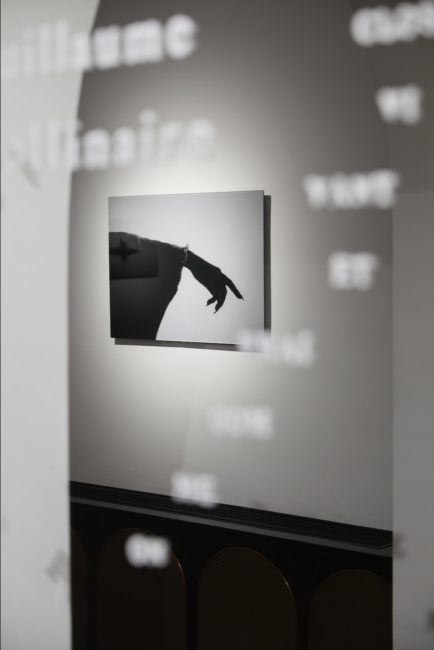I Imagine Angels
| June 5, 2023

Tomas Vu, Flatland, 2001
acrylic, silkscreen, laser cut wood veneer, pencil, and gouache on Somerset paper, 118.5×88.5 cm, 6 pictures in total.
“I Imagine Angels”, installation view, The Cloister Project, The Cloisters Apartments, Shanghai, 2022
Photo by Fengdi Ye
Courtesy the artist and The Cloister Project
Shanghai, summer, 2022: with COVID restrictions in place there can’t be a more perfect time to talk about a Kafkaesque bureaucracy and society. Even the Cloister Project where they’re talking angels, is no exception. “Messengers” or “order deliverers” is how they are described by philosophers such as France’s Michel Serres. These are, of course, terms that conceal or erase any hint of angels’ own agency and, in so doing, corroborate the authenticity and authority of the messages they convey. Though the imagined image of angels is relatively grandiose—beautiful humanoids with mighty wings—their role is relatively simple. Or so it appears. But appearances, as we all know, can be deceiving and Clement Huang has dedicated a whole exhibition to angelology, that entwines religion, fantasy, folklore, alchemy, poetry, and Romanticism, with an aesthetic approach that conceals as much as it reveals.

“I Imagine Angels”, installation view, The Cloister Project, The Cloisters Apartments, Shanghai, 2022
Photo by Fengdi Ye
Courtesy the artist and The Cloister Project
Italian philosopher Giorgio Agamben notes in his book The Kingdom and Glory (2011), ‘Sometimes, as in Tertullian’s writings, the administration of the worldly monarchy is the model of the angelic ministries, whereas at others the celestial bureaucracy furnishes the archetype for the worldly.’ Clearly, Tertullian (a second-century Christian writer) was already making analogies between earthly and heavenly orders from an early stage in the evolution of the religion. And needless to say that relationship has evolved further in the years since..

Avita Guo, White White xxx and xx Blanc Blanc xx et xx, 2022, desktop, stationeries, artificial wing, artificial flowers, wooden balls, blankets, umbrellas, lace, mirrors, tracing paper, cotton, spray paint, oil on canvas, sound installations, dimensions variable
Commissioned by Macalline Art Center
“I Imagine Angels”, installation view, The Cloister Project, The Cloisters Apartments, Shanghai, 2022
Photo by Fengdi Ye
Courtesy the artist and The Cloister Project
Avita Guo’s installation White White xxx and xx (2022), a new commission for this exhibition, takes over the whole room next to the staircase. It does what the title promises: it is white everywhere. White angel wings, laces, paper, glasses, cotton, and an umbrella are assembled into a scene that seems to suggest that an angel, which came from nowhere, has fallen into this study, smashed onto a desk and files, and—‘puff!’—disappeared, leaving behind this messy chaos. It is an intentionally unfinished still-life that wouldn’t look out of place in a Rococo painting. On the other hand it suggests connections that span: angel, angelology, and bureaucracy (‘bureau’ as a study or office). The angelic soundtrack playing in this room enhances the theatrical and suspenseful feeling, but the scale of the chambre, a 20-square-meter space, while its location, next to the staircase at once interrupts the immersive experience while simultaneously suggesting an ascent or descent (depending on your point of view)..
Another theatrical piece, but with a darker tone, is a photography series by artist duo Ohlsson/Dit-Cilinn, the Diluvians (2020). The unsaturated photos, almost black and white, picture human figures in linen robes and face coverings, standing or sitting on rafts (or a floating dock) on a peaceful body of water, as if they are the survivors of a great flood. The religious reference of this tableau vivant is obvious. Considering the year of creation, it might be a response to the pandemic, while mirroring the Biblical deluge. The still water and equally static human figures intensifies the tension within the scene which suggests the calm before another storm. With their Bergmanesque aesthetics, the five framed works also come across as stills from a motion picture, thus creating another fluidity of their own.

Ohlsson/Dit-Cilinn, Diluvians Les Diluvien·ne·s, 2020, performance with floating jetty, knitwork, ash, oar, oakmoss, synthetic furs, various textiles and lake debris, 76 × 54 cm, 5 pictures in total
“I Imagine Angels”, installation view, The Cloister Project, The Cloisters Apartments, Shanghai, 2022
Photo by Fengdi Ye
Courtesy the artist and The Cloister Project
In the other room we come across Thomas Vu’s graphic installation Flatland (2001), six pieces of silkscreen collage with gouache painting hanging from the ceiling, housed in Plexiglas to showcase each piece’s double-sided content. One side of each features modern products of technology (satellites, spaceships), rendered as celestial images, while the other sides contain texts and paragraphs from the mass media. The ‘two-sided’ nature is a literal reflection of Vu’s concern with how technology has impacted people. The work was made before the internet completely took over everything, so the work might be viewed as a bit naïve by today’s standards, when technology’s impact on humanity is immeasurable, and even irreversible, but this apparent ‘naivety’ only enhances the disturbing aspect of technology’s development is the years since. Beautiful infrastructures or flashy, celestial, glamourous spectacles are masking a dark truth.

“I Imagine Angels”, installation view, The Cloister Project, The Cloisters Apartments, Shanghai, 2022
Photo by Fengdi Ye
Courtesy the artist and The Cloister Project
Indeed, you might say that the curator has constructed this show as a (definitely European-style) theater through which to criticise the contemporary through the old, reality through imagination, the local through the alien. Because, ultimately, what’s going on right now is so hard to grasp in and of itself. In this formula, the title “I Imagine Angels” comes with a subtext: ‘I can’t believe the reality’.
Paul Han is a writer and translator based in Shanghai.

